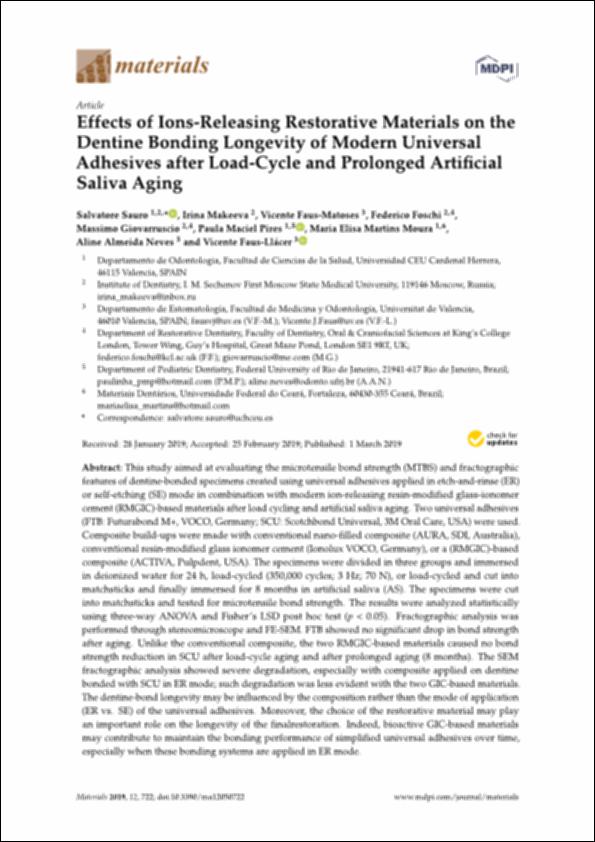Por favor, use este identificador para citar o enlazar este ítem:
http://hdl.handle.net/10637/10684Effects of ions-releasing restorative materials on the dentine bonding longevity of modern universal adhesives after load-cycle and prolonged artificial saliva aging
| Título : | Effects of ions-releasing restorative materials on the dentine bonding longevity of modern universal adhesives after load-cycle and prolonged artificial saliva aging |
| Autor : | Sauro, Salvatore. Makeeva, Irina Faus Matoses, Vicente Foschi, Federico Giovarruscio, Massimo Maciel Pires, Paula Martins Moura, Maria Elisa Almeida Neves, Aline Faus Llácer, Vicente |
| Materias: | Adhesivos dentales.; Dental adhesives.; Dentistry, Operative.; Cementos dentales.; Dentin.; Dental materials.; Dental cements.; Odontología restauradora.; Dentina.; Materiales dentales. |
| Editorial : | MDPI |
| Citación : | Sauro, S., Makeeva, I., Faus-Matoses, V., Foschi, F., Giovarruscio, M., Maciel Pires, P. et al. (2019). Effects of ions-releasing restorative materials on the dentine bonding longevity of modern universal adhesives after load-cycle and prolonged artificial saliva aging. Materials, vol. 12, n. 5 (1 march), art. 722. DOI: https://doi.org/10.3390/ma12050722 |
| Resumen : | This study aimed at evaluating the microtensile bond strength (MTBS) and fractographic features of dentine-bonded specimens created using universal adhesives applied in etch-and-rinse (ER) or self-etching (SE) mode in combination with modern ion-releasing resin-modified glass-ionomer cement (RMGIC)-basedmaterials after load cycling and artificial saliva aging. Two universal adhesives (FTB: Futurabond M+, VOCO, Germany; SCU: Scotchbond Universal, 3M Oral Care, USA) were used. Composite build-ups were made with conventional nano-filled composite (AURA, SDI, Australia), conventional resin-modified glass ionomer cement (Ionolux VOCO, Germany), or a (RMGIC)-based composite (ACTIVA, Pulpdent, USA). The specimens were divided in three groups and immersed in deionized water for 24 h, load-cycled (350,000 cycles; 3 Hz; 70 N), or load-cycled and cut into matchsticks and finally immersed for 8 months in artificial saliva (AS). The specimens were cut into matchsticks and tested for microtensile bond strength. The results were analyzed statistically using three-way ANOVA and Fisher’s LSD post hoc test (p < 0.05). Fractographic analysis was performed through stereomicroscope and FE-SEM. FTB showed no significant drop in bond strength after aging. Unlike the conventional composite, the two RMGIC-based materials caused no bond strength reduction in SCU after load-cycle aging and after prolonged aging (8 months). The SEM fractographic analysis showed severe degradation, especially with composite applied on dentine bonded with SCU in ER mode; such degradation was less evident with the two GIC-based materials. The dentine-bond longevity may be influenced by the composition rather than the mode of application (ER vs. SE) of the universal adhesives. Moreover, the choice of the restorative material may play an important role on the longevity of the finalrestoration. Indeed, bioactive GIC-based materials may contribute to maintain the bonding performance of simplified universal adhesives over time, especially when these bonding systems are applied in ER mode. |
| Descripción : | Este artículo se encuentra disponible en la página web de la revista en la siguiente URL: https://www.mdpi.com/1996-1944/12/5/722 En este artículo científico también participan los siguientes autores: Maria Elisa Martins Moura, Aline Almeida Neves and Vicente Faus-Llácer. Este artículo pertenece al número especial "Bioactive and Therapeutic Dental Materials". |
| URI : | http://hdl.handle.net/10637/10684 |
| Derechos: | http://creativecommons.org/licenses/by/4.0/deed.es |
| ISSN : | 1996-1944 |
| Fecha de publicación : | 1-mar-2019 |
| Centro : | Universidad Cardenal Herrera-CEU |
| Aparece en las colecciones: | Dpto. Odontología |
Los ítems de DSpace están protegidos por copyright, con todos los derechos reservados, a menos que se indique lo contrario.


